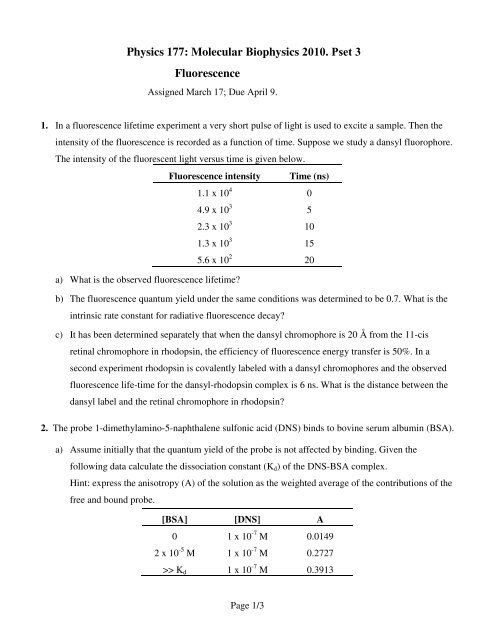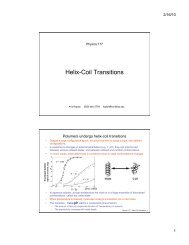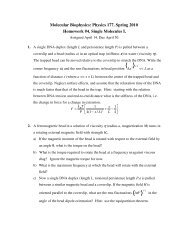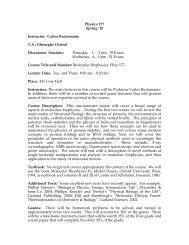Physics 177: Molecular Biophysics 2010. Pset 3 Fluorescence
Physics 177: Molecular Biophysics 2010. Pset 3 Fluorescence
Physics 177: Molecular Biophysics 2010. Pset 3 Fluorescence
Create successful ePaper yourself
Turn your PDF publications into a flip-book with our unique Google optimized e-Paper software.
<strong>Physics</strong> <strong>177</strong>: <strong>Molecular</strong> <strong>Biophysics</strong> <strong>2010.</strong> <strong>Pset</strong> 3<br />
<strong>Fluorescence</strong><br />
Assigned March 17; Due April 9.<br />
1. In a fluorescence lifetime experiment a very short pulse of light is used to excite a sample. Then the<br />
intensity of the fluorescence is recorded as a function of time. Suppose we study a dansyl fluorophore.<br />
The intensity of the fluorescent light versus time is given below.<br />
<strong>Fluorescence</strong> intensity Time (ns)<br />
1.1 x 10 4<br />
a) What is the observed fluorescence lifetime?<br />
4.9 x 10 3 5<br />
2.3 x 10 3 10<br />
1.3 x 10 3 15<br />
5.6 x 10 2 20<br />
b) The fluorescence quantum yield under the same conditions was determined to be 0.7. What is the<br />
intrinsic rate constant for radiative fluorescence decay?<br />
c) It has been determined separately that when the dansyl chromophore is 20 Å from the 11-cis<br />
retinal chromophore in rhodopsin, the efficiency of fluorescence energy transfer is 50%. In a<br />
second experiment rhodopsin is covalently labeled with a dansyl chromophores and the observed<br />
fluorescence life-time for the dansyl-rhodopsin complex is 6 ns. What is the distance between the<br />
dansyl label and the retinal chromophore in rhodopsin?<br />
2. The probe 1-dimethylamino-5-naphthalene sulfonic acid (DNS) binds to bovine serum albumin (BSA).<br />
a) Assume initially that the quantum yield of the probe is not affected by binding. Given the<br />
following data calculate the dissociation constant (Kd) of the DNS-BSA complex.<br />
Hint: express the anisotropy (A) of the solution as the weighted average of the contributions of the<br />
free and bound probe.<br />
[BSA] [DNS] A<br />
0 1 x 10 -7 M 0.0149<br />
2 x 10 -5 M 1 x 10 -7 M 0.2727<br />
>> Kd 1 x 10 -7 M 0.3913<br />
Page 1/3<br />
0
) Now assume that the quantum yield of DNS increases two-fold upon binding to BSA. Using the<br />
same values as above calculate the Kd that would explain this data.<br />
c) How would you determine whether the quantum yield of DNS changes upon binding to BSA?<br />
d) Predict the time-resolve decays of anisotropy for the solution with [BSA]>>Kd, at 20°C. Assume<br />
Po = 0.3913 for DNS and that the rotational correlation time of DNS and BSA are well<br />
approximated by that predicted for an anhydrous sphere. The molecular weight of BSA is 64,000<br />
g/mol. The viscosity of the medium is 0.894 (g cm -1 sec -1 ). The density of the protein can be<br />
assumed to be 1.3 g/cm 3 .<br />
3. The fluorescence anisotropy of a dye labeled protein was measured first as a function of temperature<br />
at a fixed viscosity and then at a constant temperature but variable viscosity. See the Perrin plot below.<br />
(Cantor and Schimmel, II, Problem 8-2)<br />
a) Derive an expression that describes the dependence of the inverse of the anisotropy (1/A) at<br />
constant temperature but variable viscosity (η ).<br />
b) Explain the data at constant viscosity but variable temperature. Specifically, why are the curves<br />
different for variable viscosity and variable temperature at high T / η and why are they the same<br />
for low T / η .<br />
c) Explain the significance of the different slopes at high T / η for these two experiments.<br />
d) Assuming that a fluorophore with lifetime 12 ns is attached to a 100 kDalton protein. Treat the<br />
protein as a sphere with average density 1.2 g/cm 3 and calculate the predicted slope of the Perrin<br />
plot.<br />
Page 2/3
4. Assume that you have isolated a protein which contains a single tryptophan residue, and which binds<br />
dinitrophenol (DNP) in the active site. The absorption spectrum of DNP overlaps with the emission<br />
spectrum of the tryptophan residue. Assume Ro = 50 Å. DNP is not fluorescent. The fluorescence<br />
intensities of the tryptophan residues are 20.5 and 4.1 in the absence and presence of DNP,<br />
respectively.<br />
a) What is the transfer efficiency?<br />
b) Assume that the unquenched lifetime is 5 ns. What is the expected life-time in the presence of<br />
DNP?<br />
c) What is the transfer rate?<br />
d) What is the distance between these groups?<br />
e) Assume that the solution conditions change so that the distance between the DNP and the<br />
tryptophan is 20 Å. What is the expected intensity for the tryptophan fluorescence?<br />
f) For this same solution (R = 20 Å) what would be the effect on the fluorescence intensity of a 1%<br />
impurity of a second protein which did not bind DNP? Assume this second protein had the same<br />
life-time and quantum yield.<br />
g) What lifetime would you expect for the sample which contains the impurity? Would this lifetime<br />
provide any indication of the presence of an impurity?<br />
Page 3/3







